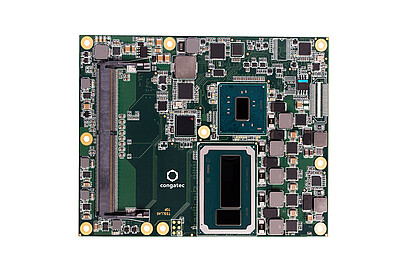conga-TS170
conga-TS170
COM Express basic type 6 module by congatec
conga-TS170, congatec’s COM Express basic type 6 module, is equipped with the 6th generation of the Intel® Core™ processor series (Skylake) and with Intel® Xeon® E3-1505 processors. Since Intel® AVX2 and OpenCL 2.0 is also supported, the conga-TS170 module is also extremely efficient at processing highly parallel tasks.
Description
The 23 GB super-fast 2133 DDR4 memory guarantees enhanced performance, which makes it ideally suited for data-intense applications. Featuring an integrated 9th generation Intel® HDT graphics card, up to three independent 4k displays (3,840 x 1,260) can be connected via HDMI 1.4, DVI and DisplayPort 1.2. In addition, a dual channel LVDS output is provided. DirectX12 and OpenGL 4.3. enable high-quality imaging including the very latest 3D features. The integrated video transcoder reduces CPU load by providing real-time video streams of various formats.
Numerous I/O interfaces, from 3rd generation PCI express to USB 3.0/2.0, LPC and I²C, allow for optimum connectivity. The conga-TS170 COM Express modules also provide connectivity for four mass storage devices via SATA III. Featuring Intel® AMT 9.1 and congatec board management controller including watch dog timer and power loss control, these modules are well equipped for remote monitoring, management and maintenance, even for out-of-band management. All common Linux and Microsoft operating systems are supported. Also, all modules are prepared for Microsoft Windows 10.
The performance of the conga-TS170 COM Express basic modules is absolutely on a par with server performance, which is due to Skylake H-series processors and the Intel® Xeon® processor class. They show off with overall performance and graphics performance. Intel’s most powerful processor graphics and media engine guarantees a compelling user experience: fast 3D rendering and realistic shading while maintaining the highest frame rates. The new conga-TS170 high-end modules find use in all industries requiring applications with individual I/O and IoT interfaces for highest performance requirements in the smallest of spaces, which is particularly true for the Internet of Things.

